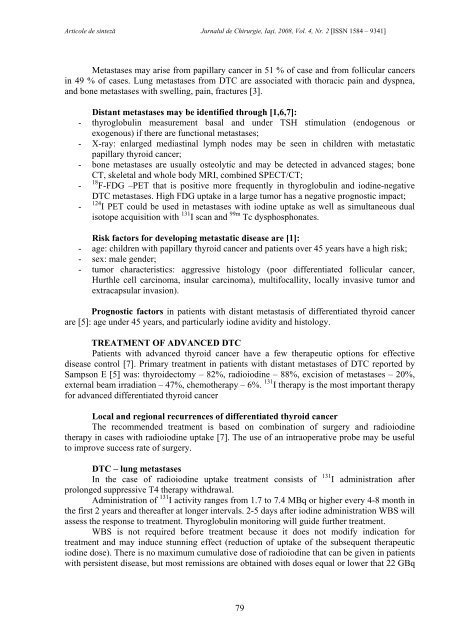Full text PDF (3.9MB) - Jurnalul de Chirurgie
Full text PDF (3.9MB) - Jurnalul de Chirurgie
Full text PDF (3.9MB) - Jurnalul de Chirurgie
You also want an ePaper? Increase the reach of your titles
YUMPU automatically turns print PDFs into web optimized ePapers that Google loves.
Articole <strong>de</strong> sinteză <strong>Jurnalul</strong> <strong>de</strong> <strong>Chirurgie</strong>, Iaşi, 2008, Vol. 4, Nr. 2 [ISSN 1584 – 9341]<br />
Metastases may arise from papillary cancer in 51 % of case and from follicular cancers<br />
in 49 % of cases. Lung metastases from DTC are associated with thoracic pain and dyspnea,<br />
and bone metastases with swelling, pain, fractures [3].<br />
Distant metastases may be i<strong>de</strong>ntified through [1,6,7]:<br />
- thyroglobulin measurement basal and un<strong>de</strong>r TSH stimulation (endogenous or<br />
exogenous) if there are functional metastases;<br />
- X-ray: enlarged mediastinal lymph no<strong>de</strong>s may be seen in children with metastatic<br />
papillary thyroid cancer;<br />
- bone metastases are usually osteolytic and may be <strong>de</strong>tected in advanced stages; bone<br />
CT, skeletal and whole body MRI, combined SPECT/CT;<br />
-<br />
18 F-FDG –PET that is positive more frequently in thyroglobulin and iodine-negative<br />
DTC metastases. High FDG uptake in a large tumor has a negative prognostic impact;<br />
-<br />
124 I PET could be used in metastases with iodine uptake as well as simultaneous dual<br />
isotope acquisition with 131 I scan and 99m Tc dysphosphonates.<br />
Risk factors for <strong>de</strong>veloping metastatic disease are [1]:<br />
- age: children with papillary thyroid cancer and patients over 45 years have a high risk;<br />
- sex: male gen<strong>de</strong>r;<br />
- tumor characteristics: aggressive histology (poor differentiated follicular cancer,<br />
Hurthle cell carcinoma, insular carcinoma), multifocallity, locally invasive tumor and<br />
extracapsular invasion).<br />
Prognostic factors in patients with distant metastasis of differentiated thyroid cancer<br />
are [5]: age un<strong>de</strong>r 45 years, and particularly iodine avidity and histology.<br />
TREATMENT OF ADVANCED DTC<br />
Patients with advanced thyroid cancer have a few therapeutic options for effective<br />
disease control [7]. Primary treatment in patients with distant metastases of DTC reported by<br />
Sampson E [5] was: thyroi<strong>de</strong>ctomy – 82%, radioiodine – 88%, excision of metastases – 20%,<br />
external beam irradiation – 47%, chemotherapy – 6%. 131 I therapy is the most important therapy<br />
for advanced differentiated thyroid cancer<br />
Local and regional recurrences of differentiated thyroid cancer<br />
The recommen<strong>de</strong>d treatment is based on combination of surgery and radioiodine<br />
therapy in cases with radioiodine uptake [7]. The use of an intraoperative probe may be useful<br />
to improve success rate of surgery.<br />
DTC – lung metastases<br />
In the case of radioiodine uptake treatment consists of 131 I administration after<br />
prolonged suppressive T4 therapy withdrawal.<br />
Administration of 131 I activity ranges from 1.7 to 7.4 MBq or higher every 4-8 month in<br />
the first 2 years and thereafter at longer intervals. 2-5 days after iodine administration WBS will<br />
assess the response to treatment. Thyroglobulin monitoring will gui<strong>de</strong> further treatment.<br />
WBS is not required before treatment because it does not modify indication for<br />
treatment and may induce stunning effect (reduction of uptake of the subsequent therapeutic<br />
iodine dose). There is no maximum cumulative dose of radioiodine that can be given in patients<br />
with persistent disease, but most remissions are obtained with doses equal or lower that 22 GBq<br />
79

















